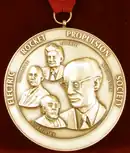Stuhlinger Medal
The Stuhlinger Medal, whose official name is the "Ernst Stuhlinger Medal for Outstanding Achievement in Electric Propulsion", is the highest honor in the field of electric propulsion for spacecraft bestowed by the Electric Rocket Propulsion Society (ERPS), the main professional society in that field, to persons who made outstanding contributions to the science, technology or development of electric propulsion.[1]
| Stuhlinger Medal (The Ernst Stuhlinger Medal for Outstanding Achievement in Electric Propulsion ) | |
|---|---|
 | |
| Awarded for | Outstanding contributions to the science, technology or development of electric propulsion for spacecraft |
| Presented by | The Electric Rocket Propulsion Society (ERPS) |
| First awarded | 2005 |
The Stuhlinger Medal was established by the ERPS in 2005 as the "Medal for Outstanding Achievement in Electric Propulsion", then renamed after its first recipient Ernst Stuhlinger (1913–2008), the German-born American rocket scientist, shortly after his death in 2008. The medal is typically awarded every two years during the ERPS's main conference, the International Electric Propulsion Conference.
Recipients

| Recipient name | Country of origin | Year of award | Comment |
|---|---|---|---|
| Mariano Andrenucci | 2011 | For his contributions to the theory and testing of various electric propulsion concepts and for his invaluable role in educating generations of scientists and leaders in electric propulsion | |
| Yoshihiro Arakawa | 2011 | For his contributions to the understanding and control of disruptive plasma behavior in EP devices and his leading role as an EP educator in Japan | |
| Monika Auweter-Kurtz | 2009 | For her sustained and productive record of contributions to various aspects of electric propulsion research and education | |
| John R. Brophy | 2015 | In recognition of his contributions to the theory and testing of various electric propulsion concepts and his leadership in the development of the ion propulsion system for the DAWN mission | |
| David "Dave" C. Byers ✝ | 2007 | For his vision, and many contributions to the advancement of electric propulsion | |
| Alec D. Gallimore | 2022 | For exemplary contributions to the understanding of EP physics and greatly expanding the scale of EP educational capabilities | |
| Dan M. Goebel | 2022 | For his outstanding contributions to the development of ion and Hall thruster technology and dissemination of EP knowledge | |
| Robert G. Jahn ✝ | 2005 | For his elucidating work on the fundamentals of electromagnetic plasma propulsion, and for his continuing legacy in EP education | |
| Harold R. Kaufman ✝ | 2005 | For his landmark development work on the electron-bombardment ion thruster, and for his innovative solutions to numerous problems in ion propulsion | |
| Vladimir Kim | 2007 | For his contributions to the solution of numerous technical problems in Hall propulsion | |
| Hitoshi Kuninaka | 2013 | For his leadership in the development of the microwave ion thruster system and of the Hayabusa Mission, the world's first asteroid sample return | |
| Kyoichi Kuriki | 2005 | For his leadership and technical contributions to EP research and space testing | |
| Horst W. Loeb ✝ | 2005 | For his landmark work on the radio-frequency ion thruster | |
| Alexei I. Morozov | 2005 | For his contributions to the understanding and development of Hall thrusters, and for his original ideas in EP | |
| Roger M. Myers | 2017 | For sustained technical and leadership Contributions to Electric Propulsion Technologies, Programs, and Applications | |
| Garri A. Popov | 2019 | For sustained technical and leadership Contributions to Electric Propulsion Technologies, Programs, and Applications | |
| Ernst Stuhlinger ✝ | 2005 | For his seminal theoretical work on ion propulsion | |
| Paul J. Wilbur ✝ | 2007 | For his seminal work and many classic contributions to ion propulsion, and for his invaluable role in EP education | |
| Askold V. Zharinov | 2011 | For his pioneering work on ExB plasma acceleration leading to his invention and development of the Thruster with Anode Layer (TAL) | |
See also
References
- "Electric Rocket Propulsion Society - Stuhlinger Medal for Outstanding Achievement". electricrocket.org. Retrieved 2023-06-05.